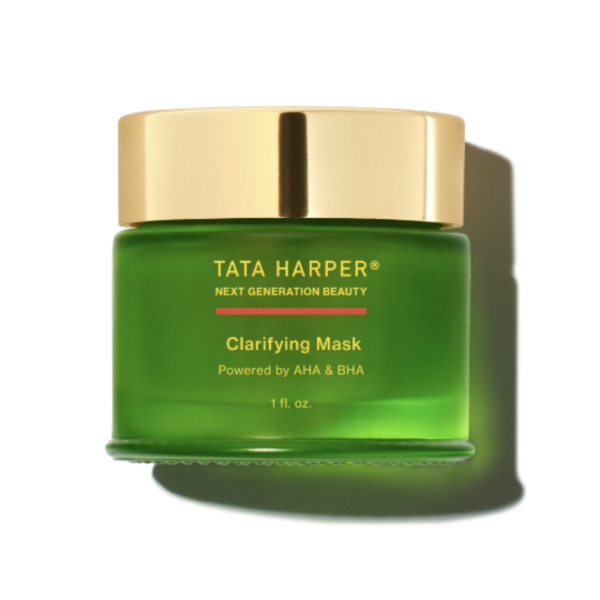All-natural, nourishing skin clarifying mask with 40 high-performance botanicals for clearer, hydrated skin
Rich source of lactic acid and salicylic acid for reduced redness, irritation, oil production, and blemishes Supports healthy balance of moisture and natural oils Powerful botanicals promote exfoliation for more youthful-looking skin with an even tone and texture Made in the USA Free of GMOs, toxins, fillers, artificial colors, artificial fragrances, and synthetic chemicals
Ingredients Concern: None
Cons: Alcohol may dry out some people's skin or cause irritation
Honey is well-known for its antibacterial, antifungal, antiviral, antioxidant, anti-inflammatory, and immune-boosting properties, all of which are beneficial for improving skin health [1-5].
Sage helps target blemishes by supporting collagen production and skin cell rejuvenation [6].
Oats help cleanse and moisturize the skin as well as soothe itchy, dry skin [7]. Therefore, oats are commonly used in skin care products [7].
Lactic acid, citrus (source of alpha-hydroxy acids), and willow bark (source of salicylic acid) are associated with gentle exfoliation and fewer skin blemishes [8, 9].
Salicylic acid targets clogged pores, promotes the shedding of dead skin cells, and helps reduce the appearance of age spots and wrinkles [8]. Willow bark has anti-inflammatory properties and helps target the signs of aging [10].
Skin moisturization and exfoliation [1, 6, 7], targets photodamaged, oily, acne-prone, combination, and blemished skin [1-10]
Due to honey's antimicrobial, antiseptic, and anti-inflammatory properties, it helps lessen oily and acne-prone skin. In addition, honey is a natural humectant that helps the skin retain moisture without making it feel oily [1-5].
Sage has an excellent nutrient profile, including essential vitamins, minerals, and antioxidants that help fortify the skin's natural defenses by neutralizing free radicals that are linked to skin damage [6].
Oats contain antioxidants that help target pro-inflammatory substances (e.g., free radicals) that can damage the skin and in doing so, they improve skin health [7].
Lactic acid, citrus, and salicylic acid promote the rejuvenation of skin cells on the outermost layer and the minimization of blemishes (e.g., scabs, dark spots). This supports renewed-looking skin and the natural emergence of new skin cells on the surface as well as in deeper layers of the skin [8, 9]. These nutrients also have antioxidant, invader-targeting, and inflammatory pathway-influencing activity [8, 9].
Salicylic acid has comedolytic properties that make it a helpful peeling agent that targets acne, melasma, photodamage, and dark spots [8]. Willow bark contains the anti-inflammatory agent salicin, which is a type of salicylate. The body can then convert salicin to salicylic acid [10].
Note regarding the Strength, Results, and Safety: The primary ingredients listed are honey, sage, lactic acid, willow bark (source of salicylic acid), oats, and silica (source of quartz crystals). These key ingredients probably confer the majority of the skin health benefits, particularly due to the texture of honey, which appears to provide the base for the mask as well as its various medicinal properties (e.g., antimicrobial, anti-inflammatory). Additional ingredients such as chlorella, wintergreen, meadowsweet, and other botanical extracts are listed further down, indicating decreasing percentages and strengths for those ingredients. In terms of safety, all of the ingredients have EWG ratings of 2 or less. Alcohol may dry out some people's skin, but it is listed as one of the last ingredients so probably a small amount is included in the formula.
Key Ingredients: Honey, Sage, Lactic acid, Willow bark, Oats, Silica
All Ingredients: Mel/Honey/Miel*, Kaolin, Salvia Officinalis (Sage) Flower/Leaf/Stem Water*, L (+) Lactic Acid, Salix Alba (Willow) Bark Extract, Glycerin, Lactobacillus/Rye Flour/Ferment, Lavandula Angustifolia (Lavender) Flower/Leaf/Stem Water*, Avena Sativa (Oat) Kernel Flour*, Maranta Arundinacea Root Powder, Aqua/Water/Eau, Avena Sativa (Oat) Kernel Oil, Glyceryl Undecylenate, Hydrated Silica, Sea Water, Tasmannia Lanceolata Fruit/Leaf Extract, Chlorella Pyrenoidosa, Vaccinium Myrtillus Fruit/Leaf Extract, Gaultheria Procumbens (Wintergreen) Leaf Extract, Saccharum Officinarum (Sugar Cane) Extract, Citrus Aurantium Dulcis (Orange) Fruit Extract, Citrus Limon (Lemon) Fruit Extract, Acer Saccharum (Sugar Maple) Extract, Pyrus Malus (Apple) Seed Oil, Santalum Spicatum Seed Oil, Rosa Rubiginosa Seed Oil*, Melaleuca Ericifolia Leaf Oil, Arnica Montana (Arnica) Extract*, Borago Officinalis (Borage) Leaf Extract*, Calendula Officinalis (Calendula) Flower Extract*, Medicago Sativa (Alfalfa) Extract*, Spiraea Ulmaria (Meadowsweet) Extract*, Leptospermum Petersonii Oil, Eucalyptus Dives Leaf/Twig Oil, Sambucus Nigra Fruit Extract, Alpha-Glucan Oligosaccharide, Pelargonium Graveolens (Geranium) Oil, Argania Spinosa Kernel Oil*, Olea Europaea (Olive) Oil*, Tocopherol, Lavandula Angustifolia (Lavender) Oil, Caprylic/Capric Triglyceride, Glyceryl Caprylate, Citrus Paradisi (Grapefruit) Oil, Sodium Citrate, Sucrose Laurate, Sodium Phytate, Citrus Aurantium (Bergamot) Peel Oil, Alcohol, CI 77288, Linalool, Limonene, Citral 
Apply a thick layer over the face and neck. Leave for 15 to 20 minutes. Massage the skin with warm water to gently exfoliate before thoroughly rinsing.
If you only have one minute, use it as an exfoliating facial scrub-massaging gently with wet hands onto dry skin and rinsing immediately with warm water.
These statements have not been evaluated by the FDA. These products are not intended to diagnose, treat, cure or prevent any disease.
1. Mandal MD, et al. Honey: its medicinal property and antibacterial activity. Asian Pac J Trop Biomed. 2011;1(2):154-160.
2. Ranneh Y, Honey and its nutritional and anti-inflammatory value. BMC Complement. Med. Ther. 2021; 21(1):30.
3. Alvarez-Suarez, JM, et al. Contribution of honey in nutrition and human health: a review. Mediterr J Nutr Metab, 2010;3:15-23
4. Nolan VC, et al. Clinical Significance of Manuka and Medical-Grade Honey for Antibiotic-Resistant Infections: A Systematic Review. Antibiotics (Basel). 2020;9(11):766.
5. Samarghandian S, et al. Honey and Health: A Review of Recent Clinical Research. Pharmacognosy Res. 2017;9(2):121-127.
6. Lu Y, Foo YL. Polyphenolics of Salvia--a review. Phytochemistry. 2002;59(2):117-40.
7. Criquet M, Roure R, Dayan L, et al. Safety and efficacy of personal care products containing colloidal oatmeal. Clin Cosmet Investig Dermatol. 2012;5:183-93.
8. Arif T. Salicylic acid as a peeling agent: a comprehensive review. Clin Cosmet Investig Dermatol. 2015;8:455-61.
9. Tang SC, Yang JH. Dual Effects of Alpha-Hydroxy Acids on the Skin. Molecules. 2018;23(4):863.
10. Gopaul R, Knaggs HE, et al. An evaluation of the effect of a topical product containing salicin on the visible signs of human skin aging. J Cosmet Dermatol. 2010;9(3):196-201.


